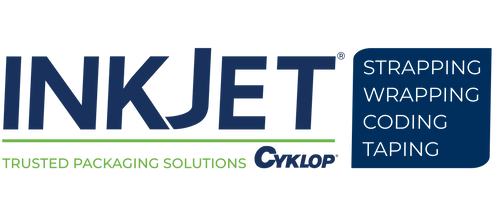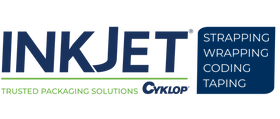Laser Marking vs. Inkjet Printing
Although laser systems and inkjet printers use very different methods to create markings, they share many of the same benefits. For example:
- They are both compatible with a wide range of materials, including metals, plastics, cardboard, and glass.
- They can both create numerous codes and images, including alphanumeric text, machine-scannable codes, and logos.
They both offer high-speed coding fast enough to meet the demands of high-output operations.
Due to these benefits and others, countless companies use laser systems and inkjet printers to outfit their products with traceable codes and required markings. Thanks to the versatility of these marking solutions, they are widely used in numerous industries, including:
Although laser systems and inkjet printers are often used to complete similar applications, they have significant differences as well. Most notably, they have different cost factors, operating requirements, and safety accommodations.
If you are looking for guidance on laser marking vs. inkjet printing, you’ve come to the right place. Here, we examine the key differences between these options, compare their specifications, and explain their ideal environments.
A Review of Today’s Laser and Inkjet Printer Systems
Laser marking systems and inkjet printers excel at high-speed product coding tasks. Their wide substrate compatibility, application versatility, and reliable results make them an excellent addition to production lines of varying sizes, specialties, and materials.
To meet different operational needs, the market is filled with laser systems and inkjet printer models that are designed with specific applications and substrates in mind. Before we jump to our comparison of laser marking vs. inkjet printing, let’s review the major laser system and inkjet printer categories.
Laser Marking System
Laser systems are categorized by beam technology. All laser systems mark materials by propelling highly focused beams of light toward substrates. Laser systems are particularly well-suited for manufacturers and high-volume packaging operations due to their:
- Fast coding speeds (~2,000 characters per second)
- 24/7 uninterrupted coding abilities
- High marking accuracy
- Large print window
- Minimal maintenance needs
Furthermore, laser users can adjust their beam settings to change how the beam interacts with the substrate. This ability allows laser systems to create multiple kinds of markings. Today’s most common laser marking techniques include coloration, ablation, and engraving.
|
|
|
|
|
|
|
|
|
|
|
|
Beam technology matters because it heavily influences a system’s material compatibility and determines what kind of markings can be made on which substrates.
Most laser marking systems today fall into one of three categories:
These categories describe the different ways that laser systems generate their beams. Fiber laser machines are solid-state lasers, meaning they use solid materials to amplify light. The “fiber” in the term “fiber laser marking machine” refers to how these machines introduce light to optic fiber to generate beams.
CO2 lasers are gas-state lasers, meaning they amplify light by introducing electricity to gas. CO2 laser systems discharge high-voltage electricity to sealed tubes of carbon dioxide, nitrogen, helium, and other gasses to induce photon emission and eventually emit light.
UV laser systems are more diverse than fiber and CO2 lasers in that they can use various materials to generate light. They can be either solid-state or gas-state lasers.
As we mentioned earlier, beam technology influences which materials a system is compatible with and what kinds of markings it can create. The chart below explains the general material compatibility of fiber, CO2, and UV lasers. For more information on laser technology, see our fiber laser buying guide.
|
|
|
|
|
|
|
|
|
|
|
|
|
|
|
|
|
|
|
|
|
|
|
|
|
|
|
|
|
|
|
|
|||
Inkjet Printer
Inkjet printers have been used to complete product coding applications since the 1950s. Today, they are still widely used by manufacturing and packaging operations due to their:
- Wide material compatibility
- Fast coding speeds
- Reliable results
However, inkjet printers are diverse. Some inkjet printers excel at high-speed coding applications, while others off
er lower speeds in exchange for better code resolutions. By and large, companies complete their product coding applications with two types of inkjet printers: continuous inkjet (CIJ) printers and thermal inkjet (TIJ) printers.
Continuous inkjet printers like the DuraCode Touchscreen and DuraCode 260-P Pigment Printer are built for high-speed production lines. Weighing around 100 pounds when filled with ink, CIJ printers can code materials moving at 300 m/min up to 24 hours a day with no interruptions. Their wide ink compatibility and piezoelectric printheads allow CIJ printers to mark flat and curved surfaces made from:
- Cardboard
- Paperboard
- Aluminum
- Glass
- Rigid plastic
- Flexible plastic/shrinkwrap
- Tetra Pak® material
- Rubber
Thermal inkjet printers are significantly more affordable than CIJ printers upfront and are generally designed for less demanding applications. Weighing around 5-10 pounds, TIJs are easy to move, install, and use. Primarily used for production line printing and available in handheld models, TIJ printers are generally slower than CIJ printers but can create codes and images with larger sizes and higher DPI resolutions.
For example, the Anser U2 SmartOne has a max coding speed of 76.2 m/min, a max print height of 25.4mm (1 inch), and a max resolution of 600 x 300 DPI. These specifications enable the SmartOne to complete product marking applications as well as case coding tasks. Advanced TIJs like the Anser X1 complete these functions with higher efficiency due to their CIJ-like printing speeds (300 m/min).
See the table below for a closer look at the differences between CIJ and TIJ printers.
|
|
|
|
|
|
|
|
|
|
|
|
|
|
|
|
|
|
|
|
|
|
|
|
|
|
|
|
|
|
|
|
|
|
|
|
|
|
|
|
|
|
|
|
|
|
|
|
|
|
|
|
Laser Marking vs. Inkjet Printing: Which Technology is Right for You?
Now that we’ve reviewed the specifications of today’s top laser and inkjet options, we can consider which marking technology may be right for you.
|
|
If you plan to mark stationary materials, laser is the marking option for you. If you do not require stationary marking or fast coding speeds, neither a laser system nor a CIJ is worth the investment price—a TIJ printer will be a better fit for your coding process and your budget.
However, if you need a precise, high-speed coding option for production line applications, how do you decide between laser and CIJ? In most cases, it comes down to cost factors.
|
|
See the chart below for a quick summary of these points, and if you have any additional questions or concerns, the InkJet, Inc. team is happy to provide answers.
|
|
|
|
|
|
|
|
|
|
|
|
|
|
|
|
|
|
|
|





